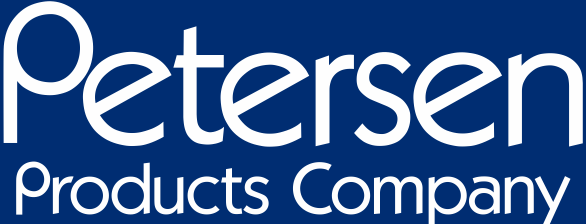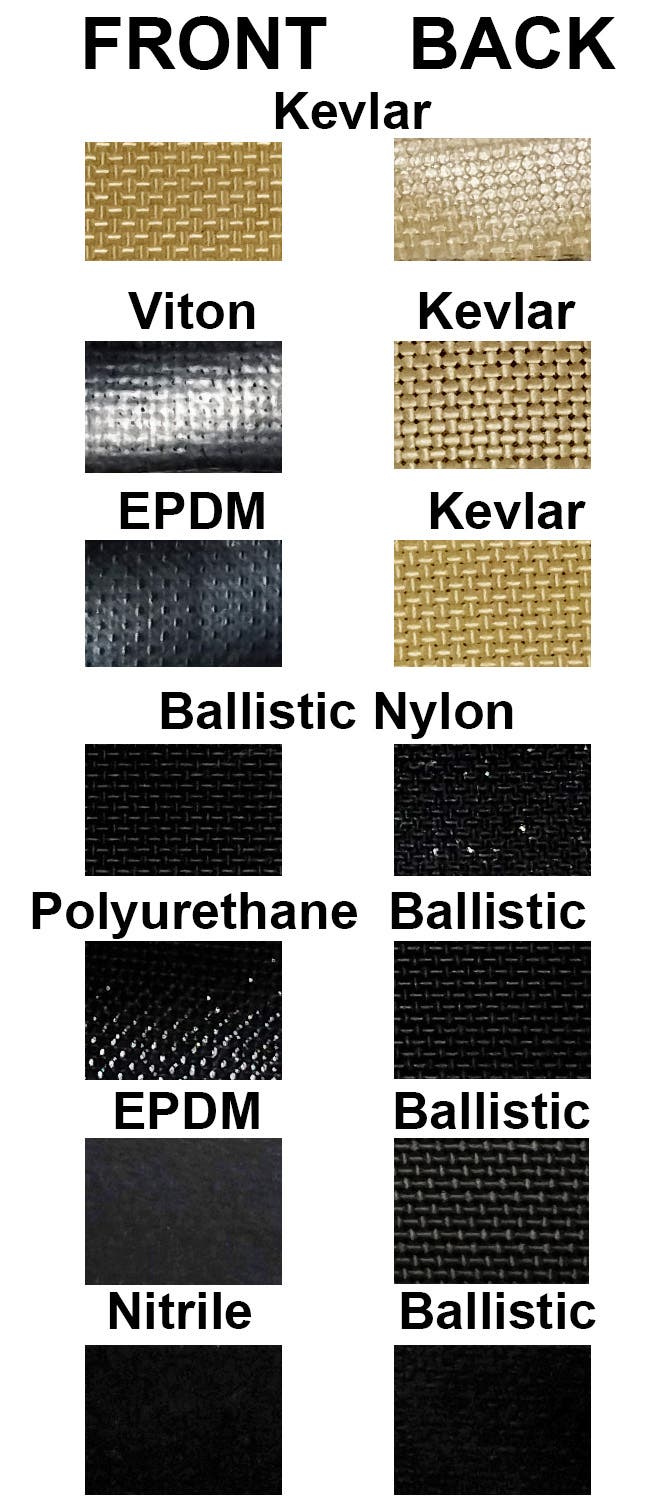Materials used for specific size, chemical, temperature and pressure requirements

Below is a list of some of the materials and coatings we use for our Multi-Flex® pipe plugs including the material, description, resistances and features/benefits.
MATERIALS
Ballistic Nylon
A type of durable synthetic fabric woven from nylon fibers in a basketweave pattern to be resistant to tearing, abrasions, and punctures.
Resistant to: chemicals such as oil, grease, water, and mildew. It is also resistant to abrasion and tear, making it a durable and versatile material for various applications.
Features/Benefits
1. Strong and durable: Ballistic nylon is woven from nylon fibers, making it extremely tough and abrasion-resistant.
2. Water-resistant: The tight weave of ballistic nylon makes it water-resistant, protecting the inside from moisture.
3. Lightweight: Despite its strength, ballistic nylon is lightweight and doesn't add excess weight to the plug.
4. Easy to clean: Ballistic nylon is easy to clean with a damp cloth.
Kevlar
A synthetic fiber developed by DuPont in 1965 that is well known for its superior strength and light weight.
Resistant to: abrasions, cuts, punctures, heat, and most chemicals, bases, and acids, making it extremely durable and reliable. Fuming nitric acid and concentrated sulfuric acid can dissolve Kevlar fibers.
Features/Benefits
1. Strength: Kevlar is five times stronger than steel on an equal-weight basis, yet it is light and flexible. It does not corrode and is able to resist chemicals and fire.
2. Durability: Kevlar is highly durable and maintains its strength for longer periods of time. It does not crack or become brittle even in extreme temperatures, making it an excellent choice for aerospace and marine applications.
3. Versatility: Kevlar can be woven or formed into various shapes and sizes, making it a great choice for a variety of applications. It can be used to form protective armor, industrial tapes, and ropes.
4. Abrasion Resistance: Kevlar is highly resistant to abrasion, making it an ideal material for safety equipment and clothing. It can also be used to form equipment like drumheads, bicycle tires, and cutting boards.
5. Energy Absorption: Kevlar can absorb tremendous amounts of energy due to its flexibility.
COATINGS
EPDM (ethylene propylene diene monomer)
A type of synthetic rubber used for a wide range of applications.
Resistant to: alkalis, acids, aliphatic hydrocarbons, steam, water, ozone, oxidation, UV radiation and alcohols.
Features/Benefits
1. Durability: EPDM rubber offers excellent resistance to ozone, sunlight and ozone. It also can withstand extreme temperatures ranging from -60°F to 300°F.
2. Hose flexibility: EPDM rubber is amazingly flexible, making it ideal for garden hoses. It also provides excellent kink and twist resistance when in use.
3. Stretching: EPDM rubber has great elongation characteristics, allowing it to stretch up to 500% of its original length without tearing or losing its elasticity.
4. Chemical resistance: It is also incredibly resistant to acids, water, alcohols, bases, and many other chemicals.
5. Thermal stability: EPDM is highly thermostable and can withstand fluids of both hot and cold temperatures.
6. Weather resistance: Due to its superior UV and ozone resistance, EPDM rubber is highly resistant to the outdoor elements, including extreme cold or hot temperatures, wind, and rain.
7. Low cost: Compared to other rubber materials, EPDM rubber is a relatively cost-effective option.
Buna-n/Nitrile
A synthetic rubber compound typically created from a copolymer of acrylonitrile and butadiene.
Resistance to: oil, fuel, and other chemicals, in comparison to other rubber materials. highly resistant to abrasion, low temperature flexibility, good tensile strength, and low tear strength. high degree of water and moisture resistance, and it has good electrical insulation properties.
Features/Benefits
1. Buna-n/Nitrile is a highly resilient material, capable of withstanding prolonged exposure to harsh conditions such as high temperatures, chemicals, and abrasion.
2. Nitrile rubber provides excellent resistance to fire and petroleum products.
3. Nitrile offers superior tensile strength and tear resistance.
4. It is a very good insulator, helping to reduce energy losses.
5. Nitrile rubber has comparatively higher strength and elongation compared to other elastomers, making it suitable for the production of complex shapes.
6. It offers excellent resistance to ozone and weathering and its temperature range is great (-40°F to 250°F).
7. Nitrile also provides superior resistance to petroleum-based fluids and wears more evenly than many other rubbers.
8. Its good resistance to vegetable and mineral oil make it an ideal material for automotive and industrial seals.
Viton
A synthetic rubber material made by DuPont Performance Elastomers.
Resistant to: a wide range of chemicals, including petroleum products, hot chemical and acid solutions, and many synthetic fluids. Viton is particularly resistant to hydrocarbons, strong acids, and fluorinated chemicals.
Features/Benefits
1. High Temperature Resistance: Viton is a type of fluoroelastomer that has a temperature range of -20°F to over 400°F. This makes it ideal for industrial and automotive applications that involve fluids and materials exposed to extreme temperatures.
2. Chemical Resistance: Viton is highly resistant to most chemicals, including acids, hydrocarbons, and industrial solvents. It also resists fuel, oil, lubricants, and automotive fluids extremely well.
3. Low Compression Set: Viton’s low compression set ensures that it’ll retain its shape and flexibility even under high cyclic loads. This is vital in applications that require frequent tension or compression.
4. Greater Strength: Viton is stronger than other related materials such as neoprene and nitrile. This makes it ideal for applications that require superior wear-resistance and strength.
5. Low Outgassing: Outgassing is the release of gas trapped inside a material. Viton does not outgas, making it ideal for applications where this would be a concern.
Polyurethane
A material composed of organic units linked by urethane links.
Resistant to: chemical solvents, oils, greases, and acids. It is also resistant to gasoline, kerosene, and alcohol.
Features/Benefits
1. Durability: Polyurethane is extremely durable and resilient, making it a great choice for furniture, flooring, and other items that must withstand frequent use.
2. Affordability: Polyurethane is an inexpensive material, so it is a great choice for those on a budget.
3. Versatility: Polyurethane can be used in a variety of applications. It is commonly used to make furniture, automotive parts, adhesives, and other items.
4. Low Maintenance: Polyurethane is easy to care for and maintain; it does not require special cleaning or treatments to keep it in good condition.
5. Safety: Polyurethane is non-toxic and does not contain any chemicals that could harm people or the environment.
Neoprene
A synthetic rubber material that is used in a variety of applications.
Resistant to: UV rays, oil, chemicals, petrol, mild acids, mineral oil, hydraulic fluids, aliphatic hydrocarbons and extreme temperatures. Excellent resistance to abrasion and tearing, moisture, meaning it will not get wet and can last long periods of time.
Features/Benefits
1. Durability: Neoprene is very durable and versatile, making it ideal for long-term, heavy-duty applications.
2. Weather resistance: Neoprene is resistant to wind, precipitation, ozone, and ultraviolet radiation.
3. Thermoplastic: Neoprene remains flexible at low temperatures, making it ideal for applications exposed to cold environments.
4. Chemical resistance: Neoprene is resistant to a wide variety of chemicals and oils, making it suitable for use in industrial settings.
5. Flame retardant: Neoprene is flame retardant, making it safer for various projects and applications.
6. Good insulation: Neoprene is a good insulator, making it perfect for projects and applications that require insulation.
7. Protection: Neoprene can be used to protect sensitive items from impact or water, making it a great choice for products exposed to the elements.
SBR (Styrene-Butadiene Rubber)
A type of synthetic rubber made from a copolymer of styrene and butadiene.
Resistant to: mild acids and caustics, oils, detergents, ozone, UV radiation, abrasion, many solvents, and weathering. It is known for its outstanding resistance to abrasion and wear as well as water resistance, heat resistance and a good insulator.
Features/Benefits
1. Weather Resistant: SB rubber is an excellent waterproof material, making it perfect for outdoor applications. It is also UV and ozone resistant, meaning it won't degrade due to exposure to the elements.
2. Durable: SB rubber is known for its durability and long lifespan. It can maintain its flexibility and structural integrity through extreme temperatures and other harsh conditions.
3. Cost Effective: SB rubber is an affordable material due to its low manufacturing costs. It is also able to be recycled, making it an eco-friendly choice.
4. High Corrosion Resistance: SB rubber is highly resistant to acid, alkalis, and other corrosive chemicals, making it an ideal material for applications that require chemical resistance.
5. Low Moisture Permeability: SB rubber has low moisture permeability, meaning it is not easily affected by changes in humidity. This makes it an ideal material for applications in damp environments.
Silicone
A synthetic material made of silicon, oxygen, and other elements, such as carbon and hydrogen.
Resistant to: UV rays, oil, chemicals, petrol, mild acids, mineral oil, hydraulic fluids, aliphatic hydrocarbons and extreme temperatures. Excellent resistance to abrasion and tearing, moisture, meaning it will not get wet and can last long periods of time.
Features/Benefits
1. Durability: Silicone is incredibly durable and can withstand a wide range of temperatures, from -148°F to 446°F (-100°C to 230°C).
2. Resistant to Aging and Ozone: Silicone has one of the longest lifespans of any elastomeric material; it’s not affected by UV radiation, humidity, or ozone.
3. Non-Stick Properties: The slippery and non-stick properties of silicone are ideal for producing non-stick cookware.
4. Low-Toxicity: Silicone is considered a safe material, as it does not contain any chemicals that are toxic to humans.
5. Resistance to Corrosion: Silicone is also resistant to corrosion and can be used in a variety of applications.
Butyl
A synthetic material made of silicon, oxygen, and other elements, such as carbon and hydrogen.
Resistant to: ozone, oxidation, and UVA and UVB radiation. It is also resistant to a wide variety of organic and inorganic acids, alkalis, alcohols, hydrocarbons, and solvents, including nitric acid, sulfuric acid, acetic acid, chloroform, trichloroethylene, and some halogenated hydrocarbons.
Features/Benefits
1. Resistance to oxidation, ozone, UV radiation and weathering.
2. Excellent sealing qualities and electrical insulation.
3. High resilience and low gas permeability.
4. Good oil and gasoline resistance.
5. Ability to withstand temperatures ranging from -60°C to +120°C.
6. Low compression set and good abrasion resistance.
7. Good flexibility even at sub-zero temperatures. 8. Excellent solvent and oil resistance.
Hypalon
A trademarked name of a synthetic rubber compound produced by DuPont.
Resistant to: ozone, UV rays, oxidation, rain, and various acids and alkalis. It also has good resistance to petroleum products, mineral oils, and solvents.
Features/Benefits
1. Durability: Hypalon is a very durable material and can withstand abrasions, cuts, and ultraviolet exposure. Its texture is strong and has excellent resistance to ozone, oxidation, and sunlight.
2. Chemical Resistance: Hypalon has excellent resistance to most chemicals, solvents, and oils. This makes it ideal for a wide range of applications.
3. Low Temperature Resistance: Hypalon can maintain its integrity and strength at very low temperatures and is often used in cold weather applications.
4. Non-Stick Surface: The surface of Hypalon is non-stick, allowing it to slip easily from other surfaces and making it ideal for lining chutes, tanks, and pipes.
5. Waterproof: Hypalon’s strong, flexible, and durable seals trap water and protect items from moisture. This makes it great for outdoor items that need waterproofing.
6. Weather Resistant: Hypalon is an excellent material for items that need to be exposed to the elements. It stands up well to heat, cold, and rain and shows minimal signs of wear.
7. Easy to Maintain: Hypalon is very easy to clean and maintain. Its non-stick surface makes it a breeze to reset after use.
Polyimides
A synthetic polymer that is known for its high temperature and chemical resistance, including acids, bases, and solvents.
Resistant to: thermal, chemical, and radiation damage.
Features/Benefits
1. High temperature stability: Polyimide materials have excellent thermal stability and maintain their mechanical and physical properties even at temperatures up to 350°C.
2. Chemical resistance: Polyimides have a high resistance to most acids, alkalis, and solvents, allowing them to be used for a variety of applications.
3. Low flammability: Polyimides are non-flammable, making them the ideal material for aerospace and automotive components, as well as other items which require fire-retardant properties.
4. Low moisture absorption: Polyimides have low moisture absorption rates, meaning they retain their mechanical properties in wet and humid environments.
5. High strength and stiffness: Polyimides are lightweight and offer superior tensile strength, modulus, and elongation-to-break properties.
6. Durability: Polyimides are lightweight and durable, making them suitable for applications which require long-term performance.
7. Flexibility: Polyimides can be modified and processed to create custom shapes, improving their ability to be formed into different products.
Fluorosilicone
A type of silicone rubber that contains a fluoro group, a type of molecule characterized by the presence of a single carbon atom surrounded by four fluorine atoms.
Resistant to: a variety of chemical solvents, fuels, oils, lubricants and many other chemically aggressive environments. These include solvents such as hydrocarbons, esters and ketones, phthalates, polychlorinated biphenyls (PCBs) and halogenated compounds. Fluorosilicones also offer excellent resistance to strong acids and bases, and have been proven to withstand temperatures ranging from -70°C to +250°C (-95°F to +480°F).
Features/Benefits
1. Fluorosilicones stand up better to extreme temperatures, making them ideal for aerospace and high-performance industrial applications.
2. Fluorosilicones have better resistance to petroleum-based oils and fuels than other silicone compositions.
3. Fluorosilicones provide greater barrier protection compared to regular silicone materials, making it ideal for water-resistant applications like electronics and appliance gaskets.
4. Fluorosilicones also stand up better to sunlight and ozone, making them well suited to outdoor applications like roofing and marine coatings.
5. Fluorosilicones are not as prone to chemical leaching as other silicone materials, which makes them a great choice for the production of food-safe and medical-grade products.




 Custom Manufacturing Solutions
Custom Manufacturing Solutions Drain Flushers & Sewer Cleaning Tools
Drain Flushers & Sewer Cleaning Tools  High Pressure Mechanical Pipe Plugs
High Pressure Mechanical Pipe Plugs  Hot Tap Machines & Equipment
Hot Tap Machines & Equipment  Inflatable Annular Seals, Bladders & Duct Plugs
Inflatable Annular Seals, Bladders & Duct Plugs  Inflatable Lifting Air Bags & Pipe Handlers
Inflatable Lifting Air Bags & Pipe Handlers  Inflatable Packer Carriers
Inflatable Packer Carriers  Inflation Accessories & Pipeline Fittings
Inflation Accessories & Pipeline Fittings  Low Pressure Mechanical Pipe Plugs
Low Pressure Mechanical Pipe Plugs  Multi-Flex® Chemical Resistant Inflatable Pipe Plugs
Multi-Flex® Chemical Resistant Inflatable Pipe Plugs  PeteStop® Inflatable Line Stop Pipe Plugs
PeteStop® Inflatable Line Stop Pipe Plugs  PeteStop® Line Stop Systems, Components & Tools
PeteStop® Line Stop Systems, Components & Tools  Pipe Plugs - Inflatable
Pipe Plugs - Inflatable  Pipe Plugs - Mechanical
Pipe Plugs - Mechanical  Pipeline Test Equipment
Pipeline Test Equipment  Rubber Molded Inflatable Pipe Plugs
Rubber Molded Inflatable Pipe Plugs  Temperature and Pressure Test Plugs
Temperature and Pressure Test Plugs  Tools for Contractors
Tools for Contractors 



